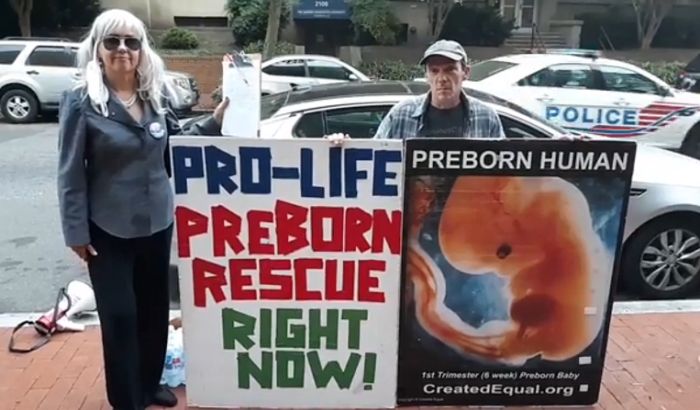The ultimate guide to understanding how abortion and breast cancer are related.
Is abortion related to breast cancer?
With an estimated 3 in 10 women having an elective abortion by the age of 45, this is a question many women understandably are afraid to ask. However, it’s one that they deserve to know the answer to. After all, in America today, 1 in every 8 American women will be diagnosed with breast cancer, and rates continue to soar in countries worldwide. More women than ever need to know: what can I do to prevent breast cancer?
For a woman, few events are more life-changing, physically, emotionally and spiritually, than pregnancy and childbirth. So many researchers have looked for answers about breast cancer by examining the delicate changes in a woman’s body through pregnancy.
Although a wealth of studies have explored cancer risk factors having to do with pregnancy, including pregnancy termination, media handling of the results has been shoddy or confused at best. But today, the scientific evidence is clearer than ever, and can no longer be ignored: abortion is a real, powerful trigger for breast cancer.
It’s called the abortion breast cancer link, or ABC link.
How does the abortion-breast cancer link work? (1)
During pregnancy, many dramatic changes occur in a woman’s body, including in her breasts. An abortion doesn’t just interrupt the pregnancy, it interrupts those changes. One result of that interruption is that it leaves her with half-transformed breast tissue that is unstable and vulnerable to cancer.
Here’s how it works.
Estrogen, a female hormone, is widely recognized as a carcinogen. This is because one of the things estrogen does is stimulate cell division. But when cell division goes awry, the result is cancer.
In a healthy pregnancy, estrogen and other hormones prepare a woman’s body for breastfeeding by developing clusters of breast tissue known as “lobules.” These hormones increase the number of lobules in the breast, and then mature them from a basic, less stable state (known as “type 1” or “type 2″) to a mature one (type 3 or 4).
Mature breast tissue (type 3 and type 4) is significantly less vulnerable to the harmful, and potentially cancer-causing effects of estrogen.
But when the changes taking place in a woman’s breasts during pregnancy are interrupted for any reason – such as a late miscarriage, a very premature delivery, or an induced abortion – the breasts will only partially develop, leaving much more unstable breast tissue (type 1 or 2) than before.
The problem is, this vulnerable breast tissue will subsequently be exposed to estrogen, either naturally during a woman’s monthly cycle, or artificially if the woman is taking a hormonal contraceptive such as the Pill.
The long and short of it is, by leaving a woman with unstable type 1 or 2 breast tissue, an induced abortion leaves a woman at considerably heightened risk of breast cancer.
The studies
When it comes to causal relationships in medicine, the proof is in the pudding.
There is an abundance of scientific data showing that terminating a pregnancy is not only a real cause of cancer, but an unusually potent one.
In fact, as of 2014, at least 28 epidemiological studies worldwide show a positive ABC link, with 21 pointing to a statistically significant risk, (2)
Two out of the three major meta-analyses on the subject support the existence of the ABC link. (3) The most recent of these in 2013 demonstrated the “dose effect,” an important indicator of causal relationship.
A 2007 multi-national study concluded that abortion was the best predictor of breast cancer out of seven factors studied in eight countries (England and Wales, Scotland, Northern Ireland, the Irish Republic, Sweden, the Czech Republic, Finland, and Denmark). (4)
The key: India
However, the most overwhelming evidence illustrating the abortion-breast cancer link comes from India.
Why India? On this subcontinent, breast cancer risk is lower than in Western countries. Experts say this is because women there usually marry early, have many children, and breastfeed – all of which are known to lower breast cancer risk. (7)
So in India, the relationship between abortion and a future breast cancer diagnosis is much easier to observe. And sure enough, the link is loud and clear. In fact, the evidence is more than clear…it is overwhelming.
The following is a list of 14 recent studies exploring the relationship between abortion and breast cancer in India. The % number represents the increased risk of breast cancer with an abortion foud in each study.
- 580% U. Raza (2011) (Pakistan)
- 179% N. Kaur (2011)
- 91% R. Lodha (2011)
- 966% A.B. Roy (2014)
- 108% S.M. Balasubramanaim (2013)
- 180% U. Talkalar (2014)
- 242% M. De Silva (2010) (Sri Lanka)
- 1,962% S. Jabeen (Bangladesh) (2013)8
- 626% A. S. Bhadoria (2013)
- 121% M. Rai (2008)
- 22% K.S. Santhy (2012)
- 155% B. Langer (2012)
- 475% R. Kamath (2013)
On average, these studies found a 439% increased risk of breast cancer.
This would mean a woman is roughly four times more likely to develop breast cancer if she has an abortion.
Are the studies trustworthy?
Studies conducted on the ABC link haven’t just found a strong correlation between abortion and breast cancer. They have also shown that the link is a causal relationship, meaning that abortion directly causes the increased risk of breast cancer, especially in high-risk cases such as women who had an abortion in their teens. (9)
However, some activists and experts have argued that the studies are tainted: either by what is known as the “recall bias,” or anti-abortion bias.
Recall bias
Some critics of the ABC link dismiss studies showing the link using the “recall bias” argument (also called “response bias” or “reporting bias”). This argument suggests that some women may misrepresent or cover up an abortion history, thereby skewing the results and making the studies irrelevant.
Endocrinologist Joel Brind, a leading expert on the ABC link, acknowledges that there is evidence that women may misrepresent their abortion history to researchers. But, he notes, the recall bias argument actually only works if healthy women (the “control” group) covered up abortion history more often than women with cancer – and, he says, plenty of data exists to show that they do not. (10)
“Anti-abortion propaganda”?
There’s no question that abortion is a deeply politically charged issue. Pro-choice activists are personally invested in showing that abortion is a harmless, everday medical procedure, while anti-abortion activists are naturally looking for evidence that abortion is harmful to women.
Some critics have even suggested that the studies on the ABC link are tainted by researchers’ personal views on abortion. However, the actual studies supporting the link are widely accepted in the scientific community. (11)
The point was put most simply by Dr. Janet Daling of the National Cancer Institute, who identifies as pro-choice and published a pivotal study in 1994 that backed the ABC link:
“If politics gets involved in science, it will really hold back the progress that we make. I have three sisters with breast cancer, and I resent people messing with the scientific data to further their own agenda, be they pro-choice or pro-life. I would have loved to have found no association between breast cancer and abortion, but our research is rock solid, and our data is accurate. It’s not a matter of believing, it’s a matter of what is.” (12)
The NCI 2003 workshop
Many medical authorities who deny the ABC link, including the American Cancer Society, the American Congress of Obstetricians and Gynecologists (ACOG), and the U.K.’s Royal College of Obstetricians and Gynaecologists (RCOG), cite the National Cancer Institute, a federally funded agency under the U.S. Department of Health and Human Services, which hosted a workshop on the issue in 2003.
NCI’s two-day symposium concluded by issuing a statement that abortion is “not associated with an increase in breast cancer risk.” (13) The agency’s public page mentions one unnamed, invited non-speaker participant who disagreed with the conclusion, and to whom, according to NCI, no one offered a rebuttal.
This participant, Dr. Joel Brind, has published detailed arguments for the flawed nature of the 2003 workshop, including the failure to invite speakers who supported the existence of the link. (14)
In fact, the strongest proof that the workshop statement was inaccurate, at best, comes from the NCI’s own published findings, which have supported the ABC link: including a 1994 study that showed a 50% increased breast cancer risk, a doubled risk after procedures before 18 or after 30 years old, and a statistically “infinite” risk when a family history of breast cancer was added. (15)
In 2009, NCI’s Dr. Louise Brinton, one of the leaders of the 2003 workshop, joined other researchers in acknowledging the abortion-breast cancer link. (16)
Word is spreading
There are many signs that public awareness of the ABC link is gaining momentum.
Doctors are now showing concern for the especially dangerous situation of teenage girls, for whom studies show breast cancer risk is higher following an abortion. (17)
For example, in 2015, the American College of Pediatricians urged women to “know their ABCs” by getting informed about the link. “When one considers the normal anatomy and physiology of the breast it becomes clear that this link is causal, not merely correlational,” said ACP president Den Trumbull. (18)
The Association of American Physicians and Surgeons has said that women considering an abortion have the right to know about the large volume of research supporting the ABC link. (19)
More facts about the ABC link:
abortion ≠ miscarriage
A miscarriage, or spontaneous abortion, is not the same as an induced abortion when it comes to breast cancer risk.
Because estrogen levels can be much lower than normal in a pregnancy destined for miscarriage, experts say, it can often leave breast tissue unaffected. (20)
The Pill
The role of estrogen in the ABC link has another big implication for women’s health: the link between breast cancer and hormonal contraceptives.
A host of studies support the conclusion that the estrogen consumed in the Pill and other contraceptives inflicts the same cancer-causing effect on breast tissue as an abortion.
Childbearing protects women (21)
There is one more step to understanding the real scope of the ABC link.
To meet statistical standards, scientific data on the ABC link means this: “a woman who never gets pregnant is safer from breast cancer than if she ends a pregnancy.” (22)
But what about the difference between choosing termination, and choosing to give birth?
Put this way, the ABC link is even more dramatic. Not only does childbirth mean no abortion, but it gives women access to well-known breast health benefits. Simply put, completing a pregnancy equips a woman with mature, stable breast tissue that is cancer-resistant. If the woman breastfeeds her baby, she protects herself from cancer even further. (23)
According to one 2012 study, bearing a child may even help women already diagnosed with cancer survive longer than those who avoid pregnancy. (24)
Even after an abortion, research shows that the sooner a woman has a full term pregnancy and breastfeeds, the less likely she is to develop breast cancer. (25)
FOOTNOTES:
1. Breastcancer.org, “Risk of Developing Breast Cancer” 10/23/2015 http://www.breastcancer.org/symptoms/understand_bc/risk/understanding
2. Angela Lanfranchi, M.D., FACS, and Patrick Fagan, Ph.D, “Breast Cancer and Induced Abortion: A Comprehensive Review of Breast Development and Pathophysiology, the Epidemiologic Literature, and Proposal for Creation of Databanks to Elucidate All Breast Cancer Risk Factors” http://www.ncbi.nlm.nih.gov/pubmed/25189012 (published here http://bcpinstitute.org/papers/ILM_Vol 29_No1_1-133.pdf)
3. J. Brind et al. (1996) http://www.ncbi.nlm.nih.gov/pmc/articles/PMC1060338/pdf/jepicomh00185-0007.pdf and Y. Huang et al. (2013) http://www.ncbi.nlm.nih.gov/pubmed/24272196 Brind’s discussion of the Huang study is available here: https://www.lifesitenews.com/opinion/meta-analysis-of-36-chinese-studies-shows-abortion-increases-breast-cancer
4. P. Carroll, “The Breast Cancer Epidemic: Modeling and Forecasts Based on Abortion and Other Risk Factors” Journal of American Physicians and Surgeons (2007) http://www.jpands.org/vol12no3/carroll.pdf
7. e.g. T. Gathani et al., “Risk Factors for Breast Cancer in India: an INDOX Case-Control Study” (ongoing) http://indox.org.uk/node/34
8. On the exceptionally strong ABC link shown in Bangladesh, Dr. Brind notes: “Almost all women in Bangladesh get married and start having children before they are 21, and breast-feed all their children as well. Consequently, breast cancer has been almost unheard of in Bangladesh, until recently.” https://www.lifesitenews.com/opinion/breast-cancer-related-to-abortion-explodes-in-asia-coverup-continues-in-the
9. Lanfranchi wrote for The National Catholic Bioethics Center in 2004: “There are six criteria that epidemiologists use to determine if an association is in fact causal.
“First, the exposure or risk must precede the disease, which [the ABC link] does in all of the studies.
“Second, the preponderance of the studies must show an association. In the case of the ABC link, 28 out of 37 studies report an association between abortion and breast cancer.
“Third, the studies must include statistically significant studies. There are 17 statistically significant studies.
“Fourth, there must be a plausible biologic basis. In the case of the ABC link, if a pregnancy is terminated before 32 weeks, the woman is left with increased numbers of type 1 and 2 lobules which are most sensitive to carcinogens. …
“Fifth, there should be a dose effect, meaning the more you are exposed to a risk, the higher the risk. … Melbye et al. 1997 (http://www.nejm.org/doi/full/10.1056/NEJM199701093360201) showed that for every week you delay an abortion, the risk of breast cancer increases by 3 percent. …
“Sixth, there must be a relative risk of over 3.0 or a 200% increased risk. In subsets of women, the relative risk is greater than 3.0. Teenagers less than age 18 who have abortions between 9 and 24 weeks have an 800% increased risk or a relative risk of 9.0 according to the NCI commissioned study, Daling et al. 1994. (http://jnci.oxfordjournals.org/content/86/21/1584)
http://www.abortionbreastcancer.com/criteria/index.htm
10. Dr. Brind discussed the history of “recall bias” in a 2005 article for The National Catholic Bioethics Quarterly (312ff.). http://www.abortionbreastcancer.com/Brind_NCBQ.PDF Also see Lanfranchi, “Breast Cancer and Induced Abortion,” 93ff. http://bcpinstitute.org/papers/ILM_Vol 29_No1_1-133.pdf
11. One important case in point is an important 1996 meta-analysis by Dr. Joel Brind, one of only three of such scope ever conducted on the issue, which some media attempted to dismiss based on Brind’s anti-abortion views. However, a review by the U.K.’s Royal College of Obstetricians and Gynecologists in 2004 affirmed that Brind et al. was a “carefully conducted” analysis with no major methodological flaws.
http://abtreibung.at/wp-content/uploads/2009/04/nebinducedabortionfull.pdf
For more on the history of ABC link data and criticism of recent studies denying the link, see: http://www.abortionbreastcancer.com/Brind_NCBQ.PDF and http://www.jpands.org/vol10no4/brind.pdf
12. “Findings Linking Cancer to Abortions a Well-Kept Secret.” Los Angeles Daily News 9/28/1997 http://www.thefreelibrary.com/FINDINGS+LINKING+CANCER+TO+ABORTIONS+A+WELL-KEPT+SECRET.-a083942541
13. National Cancer Institute, “Abortion, Miscarriage, and Breast Cancer Risk” http://www.cancer.gov/types/breast/abortion-miscarriage-risk
14. Brind, “Early Reproductive Events and Breast Cancer: A Minority Report” http://www.abortionbreastcancer.com/minorityreport/index.htm Also see “The Abortion-Breast Cancer Connection,” 322ff. http://www.abortionbreastcancer.com/Brind_NCBQ.PDF
15. J.R. Daling et al., “Risk of breast cancer among young women: relationship to induced abortion.” Journal of the National Cancer Institute (1994) http://jnci.oxfordjournals.org/content/86/21/1584
16. J. Dolle et al., “Risk Factors for Triple-Negative Breast Cancer in Women Under Age 45” Cancer Epidemiology, Biomarkers & Prevention (2009) http://cebp.aacrjournals.org/content/18/4/1157.long (full text)
17. “Research studies document a compounding of breast cancer risk factors for girls and young women that underscores the duty for full and accurate informed consent.” A. Patrick Schneider et al., Linacre Quarterly (2014) http://www.maneyonline.com/doi/pdfplus/10.1179/2050854914Y.0000000027
18. American College of Pediatricians, “Know your ABCs: the Abortion Breast Cancer Link” (April 7, 2015) http://www.acpeds.org/know-your-abcs-the-abortion-breast-cancer-link
19. AAPS executive director Jane Orient, MD said in December 2015: “The AAPS believes that patients have the right to give or withhold fully informed consent before undergoing medical treatment. This includes notification of potential adverse effects. While there is a difference of medical opinion concerning the abortion-breast cancer link, there is a considerable volume of evidence supporting this link, which is, moreover, highly plausible. We believe that a reasonable person would want to be informed of the existence of this evidence before making her decision.” (she confirmed it to me in an email since I couldn’t find an official link.)
20. See Lanfranchi, “Breast Cancer and Induced Abortion,” 16f. http://bcpinstitute.org/papers/ILM_Vol 29_No1_1-133.pdf
21. Susan G. Komen, “Does pregnancy affect breast cancer risk and survival?” https://ww5.komen.org/KomenPerspectives/Does-pregnancy-affect-breast-cancer-risk-and-survival-.html
22. Lanfranchi, “ABC Connection,” 315 http://www.abortionbreastcancer.com/Brind_NCBQ.PDF
23. V. Beral, et al. “Breast cancer and breastfeeding: collaborative reanalysis of individual data from 47 epidemiological studies in 30 countries, including 50302 women with breast cancer and 96973 women without the disease.” Lancet (2002) http://www.ncbi.nlm.nih.gov/pubmed/12133652
24. H. Azim et al., “Prognostic Impact of Pregnancy After Breast Cancer According to Estrogen Receptor Status: A Multicenter Retrospective Study” Journal of Clinical Oncology (2012) http://jco.ascopubs.org/content/early/2012/11/16/JCO.2012.44.2285.abstract
25. J.R. Daling JR, et al. “Risk of Breast Cancer Among Young Women: Relationship to Induced Abortion,” Journal of the National Cancer Institute (1994) http://jnci.oxfordjournals.org/content/86/21/1584
E. White et al. “Breast cancer among young U.S. women in relation to oral contraceptive use” Journal of National Cancer Institute (1994) http://www.ncbi.nlm.nih.gov/pubmed/8133534




